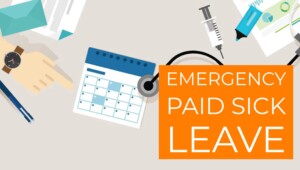 Following on the footsteps of the City of Los Angeles, City and County of San Francisco and the City of San Jose, the County of Los Angeles has also adopted an emergency Supplemental Paid Sick Leave Ordinance (SPSLO) providing paid leave that employees can use for COVID-19-related reasons. The SPSLO is intended to fill the gap left by the federal Families First Coronavirus Response Act (FFCRA). The FFCRA provides employees with up to 80 hours of paid sick leave for reasons related to COVID-19 but only applies to employers with fewer than 500 employees. The SPSLO applies to employers operating in unincorporated areas of Los Angeles County which have 500 or more employees nationally.
Following on the footsteps of the City of Los Angeles, City and County of San Francisco and the City of San Jose, the County of Los Angeles has also adopted an emergency Supplemental Paid Sick Leave Ordinance (SPSLO) providing paid leave that employees can use for COVID-19-related reasons. The SPSLO is intended to fill the gap left by the federal Families First Coronavirus Response Act (FFCRA). The FFCRA provides employees with up to 80 hours of paid sick leave for reasons related to COVID-19 but only applies to employers with fewer than 500 employees. The SPSLO applies to employers operating in unincorporated areas of Los Angeles County which have 500 or more employees nationally.
Covered Employees
The SPSLO, passed on April 28, 2020, provides up to 80 hours of emergency paid sick leave that can be used for COVID-19-related purposes. The SPSLO applies to full- and part-time employees who perform any work within the geographic unincorporated boundaries of the county and were employed as of the ordinance’s effective date. The SPSLO excludes food sector workers covered by Governor Gavin Newsome’s Executive Order (EO N-51-20), which provides food industry workers with supplemental paid sick leave for COVID-related purposes. The county ordinance allows an employer to exclude emergency responders and health care providers from the leave entitlement. The ordinance does not apply to federal, state, or local government agencies.
Reasons for Leave
Under the county ordinance, supplemental paid sick leave may be used upon written request of the employee where the employee is unable to work (or telework) due to the following COVID-19 circumstances:
- the employee is recommended to isolate or self-quarantine by a public health official or healthcare provider;
- the employee is subject to a federal, state, or local quarantine order;
- the employee needs to care for a family member who is subject to a federal, state, or local quarantine or isolation order or who has been advised by a healthcare provider to self-quarantine; or
- the employee needs time away from work to provide care for a family member whose senior care provider or whose school or child care provider ceases operations in response to a public health or other public official’s recommendation.
Supplementary Entitlement
The SPSLO provides that the supplemental paid sick leave entitlement is in addition to any paid sick leave the employee may be entitled to under existing California law. An employer may not require an employee to use any other paid or unpaid leave, paid time off, or vacation time provided by the employer before the employee takes supplemental paid sick leave. However, an employer can offset any hours of leave it may have provided to an employee since March 31, 2020 for COVID-19-related reasons, if such leave was above and beyond the employee’s regularly and previously accrued leave (e.g., sick or personal leave). Supplemental paid sick leave benefits are calculated based on the employee’s highest average two week pay over the period of January 1, 2020 through the effective date of the ordinance. Benefits are capped at $511 per day and $5,110 in the aggregate.
Enforcement of the Ordinance
The county ordinance prohibits an employer from discharging, discriminating against, or reducing the compensation of any employee who seeks supplemental paid leave or opposes any act made unlawful by the ordinance. The ordinance gives employees a private right of action against their employers for violations of the law. Remedies include reinstatement, back pay, supplemental paid sick leave at the rate of the employee’s average rate of pay, and reasonable attorneys’ fees and costs.
Employers’ obligation to provide the supplemental paid sick leave is retroactive to March 31, 2020. The county ordinance will expire on December 31, 2020, unless extended by the LA County Board of Supervisors. Given the uncertain course of the Coronavirus and the county’s plans to reopen businesses, employers are cautioned that the need to provide supplemental paid sick leave could increase over the coming months and extend beyond year’s end.
|
|

